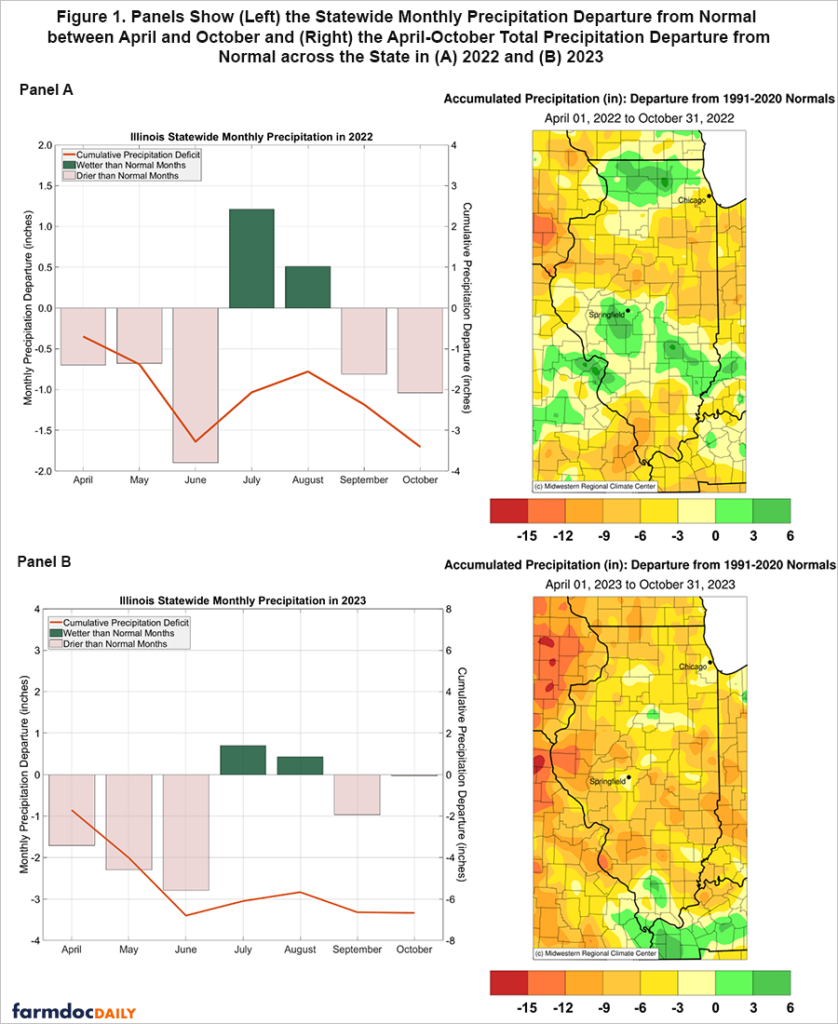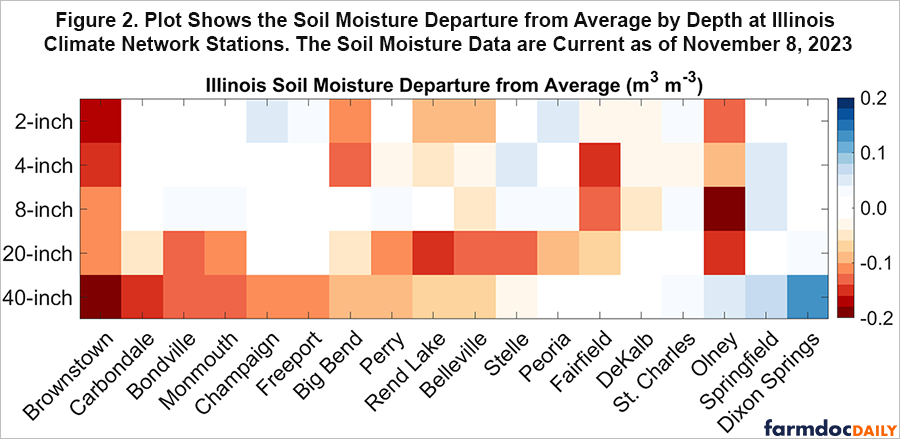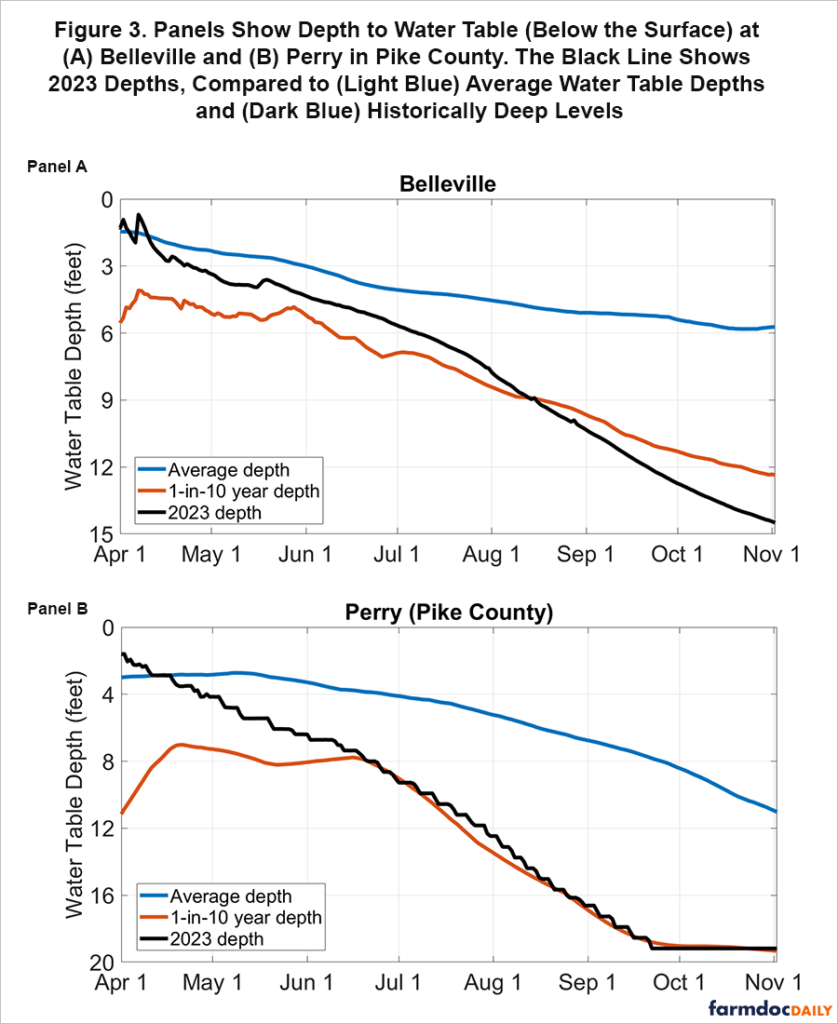Ford, T. “Don’t Sleep on Drought this Winter.” farmdoc daily (13):209, Department of Agricultural and Consumer Economics, University of Illinois at Urbana-Champaign, November 15, 2023. Permalink
The past two growing seasons have brought intense, but ephemeral periods of drought across Illinois, the combination of which has led to significant depletion of deep-layer soil moisture and streamflow and pond level reductions across large parts of the state. The agricultural impacts of these droughts have been mitigated by timely rains in July and August and by generally dry and pleasant harvest weather in 2022 and 2023. However, wetter conditions this winter and early spring would be ideal to reduce concerns of drought re-emergence next year. In particular, we would like to see soil moisture at 20-to-60-inch depths and water table levels stabilize and improve before we get too far into the 2024 growing season.
On the Timing of Recent Wet & Dry Periods
The two wettest 5-year periods on record in Illinois occurred in the last 20 years, 2007-2011 and 2015-2019, and these extremely wet periods were separated by one of the most intense droughts in the last half century. The timing of the 2012 drought, falling between two exceptionally wet periods, was undoubtedly important to limiting both the intensity and the duration of the drought. Multiple years of wetter than normal conditions in Illinois ahead of the drought helped fully stock reservoirs, shallow groundwater, streams, and soil moisture, which helped somewhat moderate the intensity of water resource impacts in 2012. Meanwhile, a flip back to very wet conditions following 2012 impeded a more serious, multi-year drought event like we saw in the 1950s (Hudson Jr., & Roberts, 1955).
While the past 2 growing seasons were not nearly as dry as 2012, the state did accumulate April-October precipitation deficits of 3.5 and 6.5 inches in 2022 and 2023, respectively (Figure 1). In both seasons, only July and August were wetter than normal statewide, providing some benefit to crops in otherwise very dry growing seasons. In fact, the 18-month period between May 2022 and October 2023 was the top 15 wettest on record in Brown, Henderson, McDonough, Vermilion, Adams, Fulton, Gallatin, and Champaign Counties, all going back to 1895. Here in Champaign County, we’ve had an average of 50.31 inches of precipitation since May 2022, which is almost 13 inches below the 30-year normal over that time. Adams County has been 16 inches drier than normal since May 2022 and 4.5 inches drier than the same period in 2012 and 2013.
Soil Dryness Shows the Legacy of Drought
The regional, growing season droughts in 2022 and 2023 have essentially eradicated the buffer of deep-layer soil moisture we built up between 2015 and 2019 in many places. Moisture in the top 8-inch soil column is near to somewhat below normal at most of the Water and Atmospheric Resources Monitoring Program (WARM Illinois Climate Network, 2023) stations across the state; however, in many places the deeper layer (20 to 40 inch) soil is very dry heading into winter (Figure 2). In fact, the 40-inch soil is driest on record for early November in Brownstown, Carbondale, Bondville, Monmouth, and Champaign.
The extended dryness has also penetrated below the root zone and affected water table levels in many places in the state. The water table at Belleville and Perry (Pike County) WARM stations (WARM Shallow Groundwater Network, 2023) has dropped below the historic 1-in-10-year depths this fall (Figure 3).
Dry deep-layer soils and deeper water table levels can affect baseflow in streams, pond and lake levels, and generally slow the recovery from hydrological drought in the state. Additionally, recent research has shown that dry deep-layer soils in winter can cause agricultural drought reemergence in the spring (Kumar et al. 2019). While deep soil dryness is not a guarantee of drought next growing season, it can be a primer of rapid drought onset in the case of dry weather in spring and early summer.
El Niño May Not be Our Friend (for Drought)
We are on our way to the first El Niño winter since 2018-19, and the first moderate-to-strong El Niño since 2015-16. When El Niño conditions in the Pacific Ocean noticeably affect our winter weather here in Illinois, we tend to have a milder and drier winter season (December – February). Moderate-to-strong El Niño events are linked with well below normal snowfall across Illinois, too. These historically strong climate signals are indicated in the latest Climate Prediction Center outlooks for climatological winter, showing higher chances of warmer and drier than normal conditions.
An El Niño event does not guarantee winter will be drier than normal, as many other factors influence our winter weather in the Midwest. However, our current El Niño conditions make it more likely to have below normal precipitation this winter, which would hamper our ability to recover from the past two years of drought.
Summary
Consecutive drier growing seasons have depleted deeper layer soil moisture and dropped water table levels across much of the state. The legacy effects of drought take longer to recover than topsoil moisture or streamflow and are important to monitor for improvement or deterioration through the winter into 2024. Without near to wetter than normal conditions in winter we may see the dry soil conditions persist into the spring, which can increase the risk of drought reemergence in the next growing season. El Niño conditions in the Pacific increase the chances of drier and warmer than normal weather, which could also impede longer-term drought recovery, especially in parts of western Illinois that have accumulated the largest deficits since the start of 2022.
Neither our existing dry soil conditions nor the potential for a drier winter necessarily guarantee we will be dealing with drought conditions next spring or summer. But those drier conditions can hasten drought onset and impacts with poorly timed dry spells in the next growing season. Therefore, it is important to watch how deeper layer soils, water table levels, streamflow, and pond levels change this winter to make sure we have the moisture we need come May.
References
Hudson Jr., H.E., and W. J. Roberts, 1955: 1952-1955 Illinois drought with special reference to impounding reservoir design. Bulletin no. 43, State of Illinois, https://www.isws.illinois.edu/pubdoc/B/ISWSB-43.pdf.
Kumar, S., Newman, M., Wang, Y., and B. Livneh, 2019: Potential reemergence of seasonal soil moisture anomalies in North America. Journal of Climate, 32, 2707-2734.
Water and Atmospheric Resources Monitoring Program. Illinois Climate Network, 2023: Illinois State Water Survey, 2204 Griffith Drive, Champaign, IL 61820-7495. https://dx.doi.org/10.13012/J8MW2F2Q.
Water and Atmospheric Resources Monitoring Program. Shallow Groundwater Network, 2023: Illinois State Water Survey, 2204 Griffith Drive, Champaign, IL 61820-7495. https://dx.doi.org/10.13012/J8CC0XMK







 and then
and then